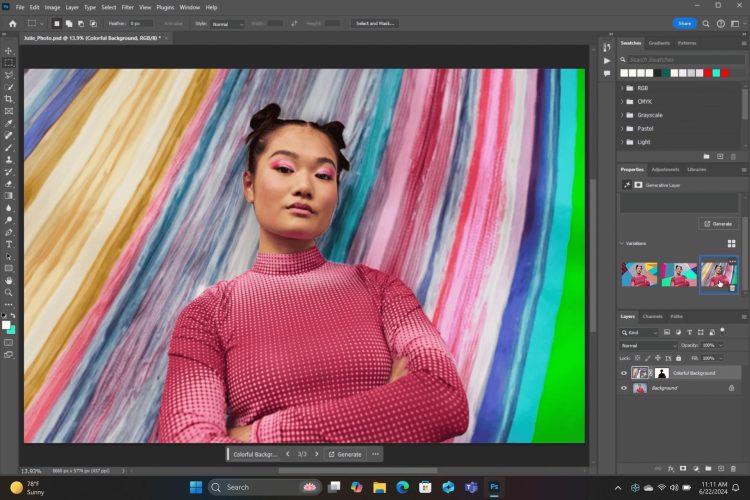Adobe has promised to bring all its tools to Windows on Arm, putting its long-standing skepticism behind it. MacBooks are usually the first computers that come to mind when Adobe is mentioned. But with its recent AI breakthroughs, Microsoft has begun to break the perception that “if your game, buy Windows, if you design, buy a MacBook”. In a preview of Microsoft’s big AI event, Microsoft introduced new Copilot features along with new Surface products.
Microsoft’s new AI computers process AI queries on-device to address privacy concerns. To this end, the firm is leveraging Qualcomm’s new Snapdragon X Elite processor to produce a range of new AI PCs, including the latest Surface Pro and Surface Laptop. Previous versions of Windows on Arm, such as the Surface Pro X, have lacked the backing of a major vendor, but that’s about to change. Adobe has promised to bring its full suite of apps to Windows on Arm, including Adobe Premier Pro. So the issue of Surface Pro X and Adobe compatibility is becoming a thing of the past.
Adobe a new page for Windows on Arm
The Surface Pro X uses a processor with Arm architecture, which Microsoft designed itself. This means that most Windows apps are designed for a fundamentally different architecture (Intel or AMD architecture). Because of this difference, these apps run through a translation layer instead of running directly on Surface Pro X. This translation process can affect performance and cause compatibility issues. For the most part, this is not a problem and web apps can be used. However, some applications, such as Slack, can run slowly.
The biggest issue, though, is compatibility beyond overall performance. Microsoft has split the Windows system in two with Surface. Computers with Arm processors are a completely new operating system, but Microsoft mimics Windows to avoid this burden. But this time, if an application is designed to run natively on Arm, processors on Intel and AMD architectures need to emulate the designed application to run in an x86 environment. Some companies, and of course Adobe, have chosen to block most of their applications from the Windows on Arm product line altogether because of the potential problems caused by emulation. This fact alone has made the Windows on Arm product line completely unusable for many industries and creative individuals.

Adobe’s growing presence on Windows on Arm
Adobe’s integration into Windows on Arm has been slow overall, but not non-existent. A few apps, including Photoshop, have been developed natively for Arm, but at Microsoft’s big AI and Surface event, Adobe promised broader support. In an announcement made during the event, Adobe said that all of its apps, including Adobe Premier Pro, will be coming “soon” to Microsoft’s new AI computers powered by the Snapdragon X Elite SoC. Until now, Adobe Premier Pro required an x86 processor to run on a Windows-based device.
Windows on Arm already has alternatives for high-end video editing, such as DaVinci Resolve. But many don’t want to change their workflow to learn a new program and adopt new silicon. Fortunately, Adobe is not forcing those interested in Windows on Arm to make a choice.
Adobe’s Creative Cloud comes to Copilot+ PCs
Not only Surface, but all computers that Microsoft defines as Copilot+ will be able to benefit from the innovations. Microsoft said in a statement:
“Together with Adobe, we’re excited to announce that Adobe’s flagship apps like Photoshop, Lightroom and Express are coming to Copilot+ PCs. Illustrator, Premiere Pro and more are coming this summer. And we’re continuing our partnership to optimize the AI in these apps for NPU. Adobe Creative Cloud customers will get all the performance benefits of Copilot+ PCs to express their creativity faster than ever before.”
NPU, in this case, refers to the new Neural Processing Units that Microsoft is incorporating into its new AI computers. Often, neural workflows are handled by graphics cards or CPUs in today’s laptops, but they are more likely to be offloaded to the cloud at Adobe or Microsoft’s headquarters. Setting up photos to use Adobe Photoshop’s generative AI extension feature in Windows Central articles sometimes takes a while because it first sends the data to Adobe’s cloud servers. It’s possible to do this on-device today, but using these specialized NPU chips should be more efficient and produce similar results on Adobe’s full cloud array.
Adobe finds a new Arm home
When companies like Apple or Microsoft introduce new platforms, there are often comments from Adobe. While there are great alternatives to Adobe Animate, Premier, or Photoshop, Adobe’s suite remains the industry standard. The lack of full Adobe support in Windows on Arm would have prevented thousands of creative individuals and even entire industries from considering a Copilot+ AI computer or the new Surface Pro 11th Gen, so this is a big boost for the platform overall.
With all this excitement revolving around the Snapdragon X Elite SoC, it remains to be seen how Intel will respond. The Snapdragon X Elite’s power efficiency, coupled with support from key players like Adobe, really makes Intel look old-fashioned. But the next-generation Intel lineup is on its way, and it is firmly focused on the Snapdragon X Elite series.
Featured image credit: Microsoft Blog





